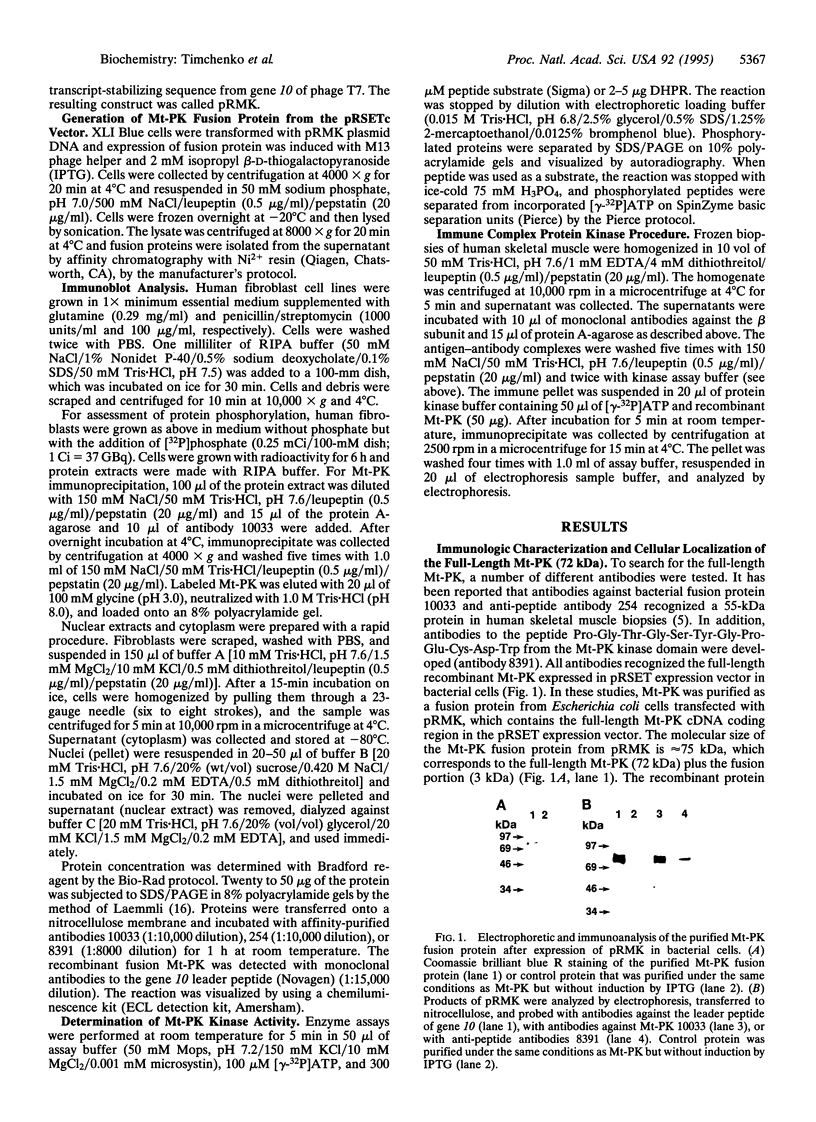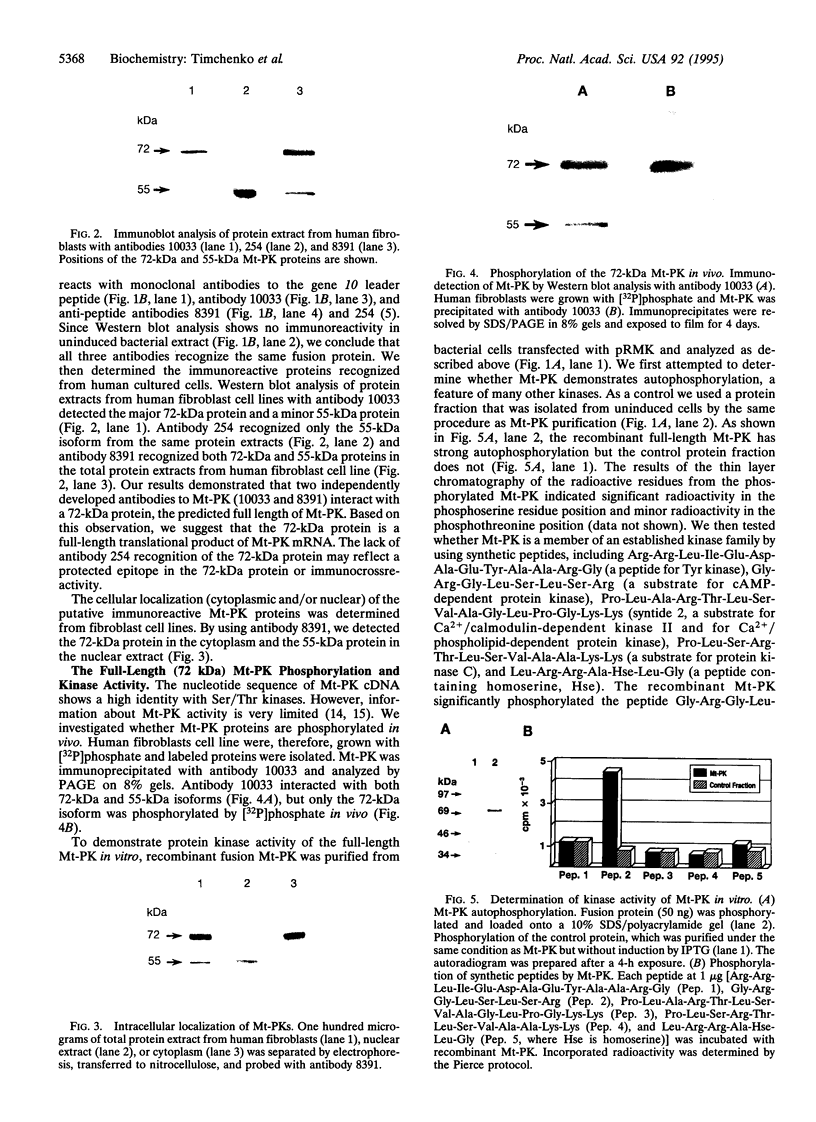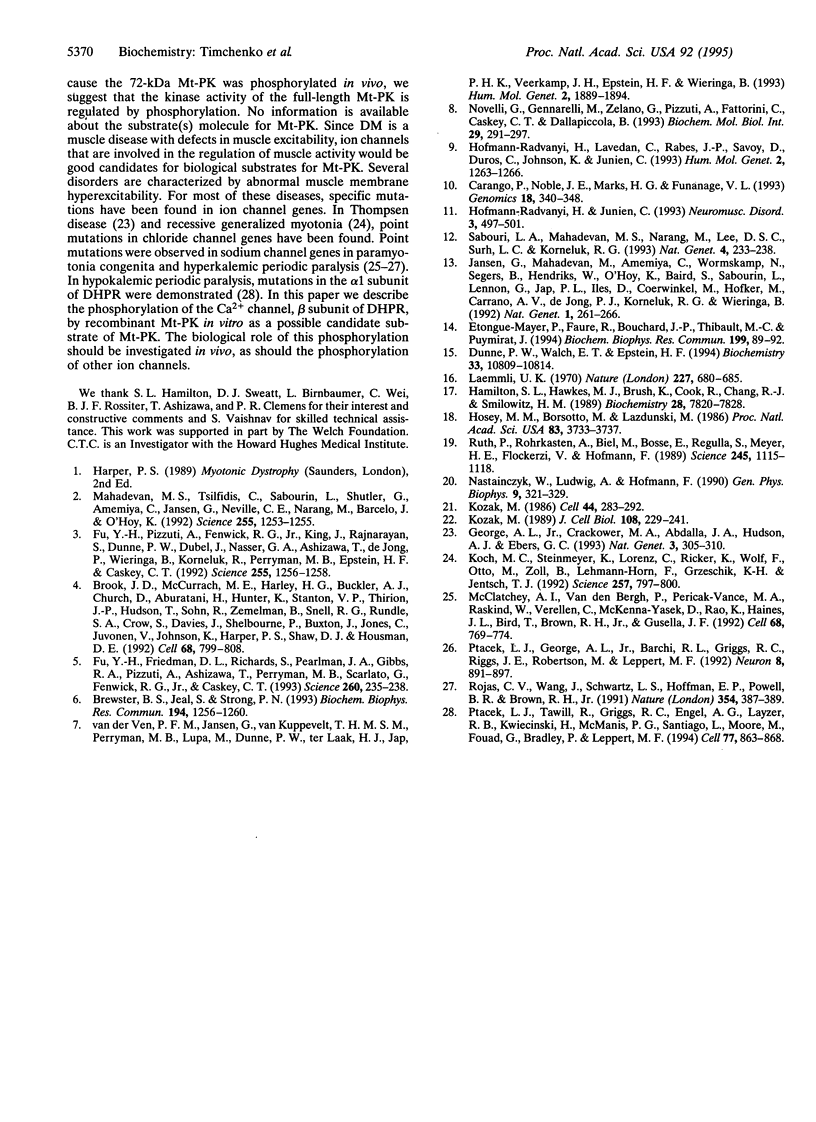Abstract
We describe the full-length (72 kDa) myotonin protein kinase (Mt-PK) and demonstrate its kinase activity. The 72-kDa protein corresponds to the translation product from the first in-frame AUG codon. This protein was found in the cytoplasmic fraction, whereas the previously reported 55-kDa protein was observed in nuclear extracts. Only the 72-kDa protein was phosphorylated by [32P]phosphate in normal human fibroblasts. To investigate the putative kinase activity of Mt-PK, a construct containing the full-length open reading frame of Mt-PK was expressed in bacterial cells. The recombinant Mt-PK autophosphorylates a Ser residue and phosphorylates the synthetic peptide Gly-Arg-Gly-Leu-Ser-Leu-Ser-Arg, which contains a Ser residue in the phosphorylation site. We examined phosphorylation of the voltage-dependent Ca(2+)-release channel, or dihydropyridine receptor (DHPR), by recombinant Mt-PK. We observed that the beta subunit of DHPR was phosphorylated in vitro by Mt-PK. A beta-subunit DHPR peptide containing some of the Ser residues predicted to be phosphorylated was synthesized and found to be a substrate for Mt-PK in vitro. We conclude that the 72-kDa Mt-PK has a protein kinase activity specific for Ser residues.
Full text
PDF




Images in this article
Selected References
These references are in PubMed. This may not be the complete list of references from this article.
- Brewster B. S., Jeal S., Strong P. N. Identification of a protein product of the myotonic dystrophy gene using peptide specific antibodies. Biochem Biophys Res Commun. 1993 Aug 16;194(3):1256–1260. doi: 10.1006/bbrc.1993.1958. [DOI] [PubMed] [Google Scholar]
- Brook J. D., McCurrach M. E., Harley H. G., Buckler A. J., Church D., Aburatani H., Hunter K., Stanton V. P., Thirion J. P., Hudson T. Molecular basis of myotonic dystrophy: expansion of a trinucleotide (CTG) repeat at the 3' end of a transcript encoding a protein kinase family member. Cell. 1992 Feb 21;68(4):799–808. doi: 10.1016/0092-8674(92)90154-5. [DOI] [PubMed] [Google Scholar]
- Carango P., Noble J. E., Marks H. G., Funanage V. L. Absence of myotonic dystrophy protein kinase (DMPK) mRNA as a result of a triplet repeat expansion in myotonic dystrophy. Genomics. 1993 Nov;18(2):340–348. doi: 10.1006/geno.1993.1474. [DOI] [PubMed] [Google Scholar]
- Dunne P. W., Walch E. T., Epstein H. F. Phosphorylation reactions of recombinant human myotonic dystrophy protein kinase and their inhibition. Biochemistry. 1994 Sep 6;33(35):10809–10814. doi: 10.1021/bi00201a031. [DOI] [PubMed] [Google Scholar]
- Etongué-Mayer P., Faure R., Bouchard J. P., Thibault M. C., Puymirat J. The myotonin-protein kinase phosphorylates tyrosine residues in normal human skeletal muscle. Biochem Biophys Res Commun. 1994 Feb 28;199(1):89–92. doi: 10.1006/bbrc.1994.1198. [DOI] [PubMed] [Google Scholar]
- Fu Y. H., Friedman D. L., Richards S., Pearlman J. A., Gibbs R. A., Pizzuti A., Ashizawa T., Perryman M. B., Scarlato G., Fenwick R. G., Jr Decreased expression of myotonin-protein kinase messenger RNA and protein in adult form of myotonic dystrophy. Science. 1993 Apr 9;260(5105):235–238. doi: 10.1126/science.8469976. [DOI] [PubMed] [Google Scholar]
- Fu Y. H., Pizzuti A., Fenwick R. G., Jr, King J., Rajnarayan S., Dunne P. W., Dubel J., Nasser G. A., Ashizawa T., de Jong P. An unstable triplet repeat in a gene related to myotonic muscular dystrophy. Science. 1992 Mar 6;255(5049):1256–1258. doi: 10.1126/science.1546326. [DOI] [PubMed] [Google Scholar]
- George A. L., Jr, Crackower M. A., Abdalla J. A., Hudson A. J., Ebers G. C. Molecular basis of Thomsen's disease (autosomal dominant myotonia congenita). Nat Genet. 1993 Apr;3(4):305–310. doi: 10.1038/ng0493-305. [DOI] [PubMed] [Google Scholar]
- Hamilton S. L., Hawkes M. J., Brush K., Cook R., Chang R. J., Smilowitz H. M. Subunit composition of the purified dihydropyridine binding protein from skeletal muscle. Biochemistry. 1989 Sep 19;28(19):7820–7828. doi: 10.1021/bi00445a044. [DOI] [PubMed] [Google Scholar]
- Hofmann-Radvanyi H., Junien C. Myotonic dystrophy: over-expression or/and under-expression? A critical review on a controversial point. Neuromuscul Disord. 1993 Sep-Nov;3(5-6):497–501. doi: 10.1016/0960-8966(93)90104-r. [DOI] [PubMed] [Google Scholar]
- Hofmann-Radvanyi H., Lavedan C., Rabès J. P., Savoy D., Duros C., Johnson K., Junien C. Myotonic dystrophy: absence of CTG enlarged transcript in congenital forms, and low expression of the normal allele. Hum Mol Genet. 1993 Aug;2(8):1263–1266. doi: 10.1093/hmg/2.8.1263. [DOI] [PubMed] [Google Scholar]
- Hosey M. M., Borsotto M., Lazdunski M. Phosphorylation and dephosphorylation of dihydropyridine-sensitive voltage-dependent Ca2+ channel in skeletal muscle membranes by cAMP- and Ca2+-dependent processes. Proc Natl Acad Sci U S A. 1986 Jun;83(11):3733–3737. doi: 10.1073/pnas.83.11.3733. [DOI] [PMC free article] [PubMed] [Google Scholar]
- Jansen G., Mahadevan M., Amemiya C., Wormskamp N., Segers B., Hendriks W., O'Hoy K., Baird S., Sabourin L., Lennon G. Characterization of the myotonic dystrophy region predicts multiple protein isoform-encoding mRNAs. Nat Genet. 1992 Jul;1(4):261–266. doi: 10.1038/ng0792-261. [DOI] [PubMed] [Google Scholar]
- Koch M. C., Steinmeyer K., Lorenz C., Ricker K., Wolf F., Otto M., Zoll B., Lehmann-Horn F., Grzeschik K. H., Jentsch T. J. The skeletal muscle chloride channel in dominant and recessive human myotonia. Science. 1992 Aug 7;257(5071):797–800. doi: 10.1126/science.1379744. [DOI] [PubMed] [Google Scholar]
- Kozak M. Point mutations define a sequence flanking the AUG initiator codon that modulates translation by eukaryotic ribosomes. Cell. 1986 Jan 31;44(2):283–292. doi: 10.1016/0092-8674(86)90762-2. [DOI] [PubMed] [Google Scholar]
- Kozak M. The scanning model for translation: an update. J Cell Biol. 1989 Feb;108(2):229–241. doi: 10.1083/jcb.108.2.229. [DOI] [PMC free article] [PubMed] [Google Scholar]
- Laemmli U. K. Cleavage of structural proteins during the assembly of the head of bacteriophage T4. Nature. 1970 Aug 15;227(5259):680–685. doi: 10.1038/227680a0. [DOI] [PubMed] [Google Scholar]
- Mahadevan M., Tsilfidis C., Sabourin L., Shutler G., Amemiya C., Jansen G., Neville C., Narang M., Barceló J., O'Hoy K. Myotonic dystrophy mutation: an unstable CTG repeat in the 3' untranslated region of the gene. Science. 1992 Mar 6;255(5049):1253–1255. doi: 10.1126/science.1546325. [DOI] [PubMed] [Google Scholar]
- McClatchey A. I., Van den Bergh P., Pericak-Vance M. A., Raskind W., Verellen C., McKenna-Yasek D., Rao K., Haines J. L., Bird T., Brown R. H., Jr Temperature-sensitive mutations in the III-IV cytoplasmic loop region of the skeletal muscle sodium channel gene in paramyotonia congenita. Cell. 1992 Feb 21;68(4):769–774. doi: 10.1016/0092-8674(92)90151-2. [DOI] [PubMed] [Google Scholar]
- Nastainczyk W., Ludwig A., Hofmann F. The dihydropyridine-sensitive calcium channel of the skeletal muscle: biochemistry and structure. Gen Physiol Biophys. 1990 Aug;9(4):321–329. [PubMed] [Google Scholar]
- Novelli G., Gennarelli M., Zelano G., Pizzuti A., Fattorini C., Caskey C. T., Dallapiccola B. Failure in detecting mRNA transcripts from the mutated allele in myotonic dystrophy muscle. Biochem Mol Biol Int. 1993 Feb;29(2):291–297. [PubMed] [Google Scholar]
- Ptácek L. J., George A. L., Jr, Barchi R. L., Griggs R. C., Riggs J. E., Robertson M., Leppert M. F. Mutations in an S4 segment of the adult skeletal muscle sodium channel cause paramyotonia congenita. Neuron. 1992 May;8(5):891–897. doi: 10.1016/0896-6273(92)90203-p. [DOI] [PubMed] [Google Scholar]
- Ptácek L. J., Tawil R., Griggs R. C., Engel A. G., Layzer R. B., Kwieciński H., McManis P. G., Santiago L., Moore M., Fouad G. Dihydropyridine receptor mutations cause hypokalemic periodic paralysis. Cell. 1994 Jun 17;77(6):863–868. doi: 10.1016/0092-8674(94)90135-x. [DOI] [PubMed] [Google Scholar]
- Rojas C. V., Wang J. Z., Schwartz L. S., Hoffman E. P., Powell B. R., Brown R. H., Jr A Met-to-Val mutation in the skeletal muscle Na+ channel alpha-subunit in hyperkalaemic periodic paralysis. Nature. 1991 Dec 5;354(6352):387–389. doi: 10.1038/354387a0. [DOI] [PubMed] [Google Scholar]
- Ruth P., Röhrkasten A., Biel M., Bosse E., Regulla S., Meyer H. E., Flockerzi V., Hofmann F. Primary structure of the beta subunit of the DHP-sensitive calcium channel from skeletal muscle. Science. 1989 Sep 8;245(4922):1115–1118. doi: 10.1126/science.2549640. [DOI] [PubMed] [Google Scholar]
- Sabouri L. A., Mahadevan M. S., Narang M., Lee D. S., Surh L. C., Korneluk R. G. Effect of the myotonic dystrophy (DM) mutation on mRNA levels of the DM gene. Nat Genet. 1993 Jul;4(3):233–238. doi: 10.1038/ng0793-233. [DOI] [PubMed] [Google Scholar]
- van der Ven P. F., Jansen G., van Kuppevelt T. H., Perryman M. B., Lupa M., Dunne P. W., ter Laak H. J., Jap P. H., Veerkamp J. H., Epstein H. F. Myotonic dystrophy kinase is a component of neuromuscular junctions. Hum Mol Genet. 1993 Nov;2(11):1889–1894. doi: 10.1093/hmg/2.11.1889. [DOI] [PubMed] [Google Scholar]








